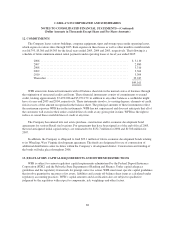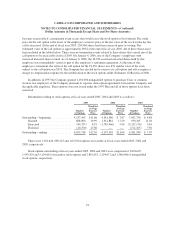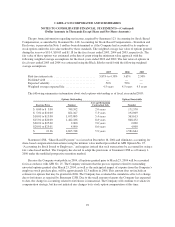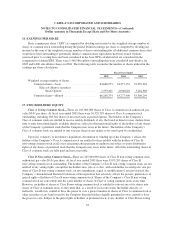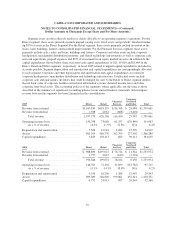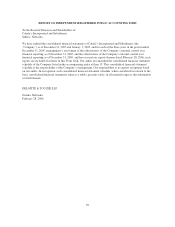Cabela's 2005 Annual Report Download - page 105
Download and view the complete annual report
Please find page 105 of the 2005 Cabela's annual report below. You can navigate through the pages in the report by either clicking on the pages listed below, or by using the keyword search tool below to find specific information within the annual report.
CABELA’S INCORPORATED AND SUBSIDIARIES
NOTES TO CONSOLIDATED FINANCIAL STATEMENTS—(Continued)
(Dollar Amounts in Thousands Except Share and Per Share Amounts)
16. EARNINGS PER SHARE
Basic earnings per share (“EPS”) is computed by dividing net income by the weighted average number of
shares of common stock outstanding during the period. Diluted earnings per share is computed by dividing net
income by the sum of the weighted average number of shares outstanding plus all additional common shares that
would have been outstanding if potentially dilutive common share equivalents had been issued. Options
exercised prior to vesting have not been considered in the basic EPS calculation but are considered in the
computation of diluted EPS. There were 1,446,186 options outstanding that were considered anti-dilutive for
2005 and 6,000 anti-dilutive shares in 2004. The following table reconciles the number of shares utilized in the
earnings per share calculations:
Fiscal Years Ended
2005 2004 2003
Weighted average number of shares:
Common shares—basic ........................ 64,668,973 61,277,352 52,059,926
Effect of dilutive securities:
Stock Options ....................... 1,599,401 2,000,048 3,246,368
Common shares—diluted ...................... 66,268,374 63,277,400 55,306,294
17. STOCKHOLDERS’ EQUITY
Class A Voting Common Stock—There are 245,000,000 shares of Class A common stock authorized, par
value $0.01 per share. At fiscal year ended 2005 there were 56,929,795 shares of Class A common stock
outstanding, including 238,546 shares of unvested early exercised options. The holders of the Company’s
Class A common stock are entitled to receive ratably dividends, if any, the board of directors may declare from
time to time from funds legally available therefore, subject to the preferential rights of the holders of any shares
of the Company’s preferred stock that the Company may issue in the future. The holders of the Company’s
Class A common stock are entitled to one vote per share on any matter to be voted upon by stockholders.
Upon any voluntary or involuntary liquidation, dissolution or winding up of the Company’s affairs, the
holders of the Company’s Class A common stock are entitled to share ratably with the holders of Class B
non-voting common stock in all assets remaining after payment to creditors and subject to prior distribution
rights of any shares of preferred stock that the Company may issue in the future. All of the outstanding shares of
Class A common stock are fully paid and non-assessable.
Class B Non-voting Common Stock—There are 245,000,000 shares of Class B non-voting common stock
authorized, par value $0.01 per share. At fiscal year ended 2005 there were 8,073,205 shares of Class B
non-voting common stock outstanding. The holders of the Company’s Class B non-voting common stock are not
entitled to any voting rights, except that the holders may vote as a class, with each holder receiving one vote per
share of Class B non-voting common stock, on any amendment, repeal or modification of any provision of the
Company’s Amended and Restated Certificate of Incorporation that adversely affects the powers, preferences or
special rights of holders of Class B non-voting common stock. Shares of the Company’s Class B non-voting
common stock are convertible into the same number of shares of Class A voting common stock at any time.
However, no holder of shares of Class B non-voting common stock is entitled to convert any of its shares into
shares of Class A common stock, to the extent that, as a result of such conversion, the holder directly, or
indirectly, would own, control or have the power to vote a greater number of shares of Class A common stock or
other securities of any kind issued by the Company than the holder is legally permitted to own, control or have
the power to vote. Subject to the prior rights of holders of preferred stock, if any, holders of Class B non-voting
93







